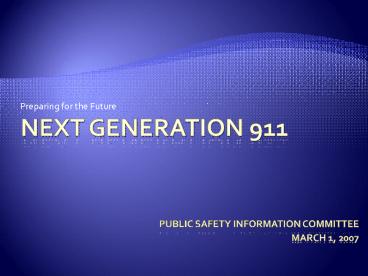Next Generation 911 - PowerPoint PPT Presentation
1 / 17
Title:
Next Generation 911
Description:
Voice, text, or video from many types of communications devices. Advanced data capabilities ' ... Uses landline phone system infrastructure and 9-1-1 call routing. ... – PowerPoint PPT presentation
Number of Views:133
Avg rating:3.0/5.0
Title: Next Generation 911
1
Next Generation 911
- Preparing for the Future
Public Safety Information Committee March 1, 2007
2
Introduction
- Emergency calls today are primarily voice.
- People expect to reach PSAP when dials 911.
- People have multiple ways and devices to
communicate today. - Traditional 9-1-1 system does not work well with
new devices. - Identity Line number, Location billing
address - Covering limited area
- National protocols and routing
- Three (related) fundamental problems
- Where is the caller?
- To which PSAP should the call go to?
- How to identify the emergency call?
- New communication devices are intelligent.
3
It has served us well, but ..
- Todays 9-1-1
- Future 9-1-1
- Primarily voice calls via telephones
- Minimal data
- Local access, transfer, and backup
- Voice, text, or video from many types of
communications devices - Advanced data capabilities
- Long Distance access, transfer, and backup
4
Assumptions and Constraints
- 9-1-1 local
- Communications IP
- NG9-1-1 gt 9-1-1
- Phased implementation
- No federal mandate
- No degradation in the current system
- Market driving the need
5
Four Phases of Emergency Calls
6
Four Ways to Access 9-1-1 Today
7
NG 9-1-1 Goals and Objectives
- Enable E9-1-1 calls from any networked
communication device. - Enable geographic-independent call access,
transfer, and backup among PSAPs and between
PSAPs and other authorized emergency
organizations. - Encourage an open architecture, interoperable
internetwork of all emergency organizations. - Reduce emergency services capital, operating, and
maintenance costs.
8
NG 9-1-1 Goals and Objectives
- Provide opportunities to enhance 911 system
- Multimedia (audio, video, text)
- Data delivery (floor plan, medical information)
- Delivering video (CPR how-to)
- Load balancing and redundancy
9
The Mission of the PSAP
- Remains the same within an NG9-1-1 system
- to receive emergency calls from the public
- ascertain the nature, status and location of the
emergency, - and relay the call to the appropriate public
safety dispatch center for response to the
emergency. - The call-related expectations of the PSAPs also
remain the same .
10
NG9-1-1 changes the core capabilities of
emergency services in three areas
- types of calls received
- ability to transfer/receive calls from PSAPs
outside the local region - and capability to accept additional information
designed to facilitate emergency services. - These are expansions of current functions, not
fundamentally new roles.
11
Third Party Emergency Provider
- Scenario 1 Telematics andNG9-1-1
12
(No Transcript)
13
(No Transcript)
14
Communicating with the Hearing Impaired
- Scenario 2 Interactive Text Scenario
15
Dealing with a hurricane
- Scenario 3 PSAP Backup/Overload
16
Next Generation 9-1-1
- Communication devices are already here
- The current system is having trouble adapting
- There are more and better services that we can
provide - We need to be planning and moving in that
direction
17
Next Generation 911
- Preparing for the Future
Public Safety Information Committee March 1, 2007































